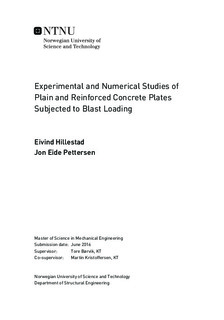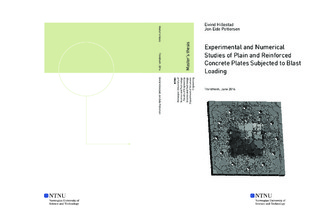| dc.description.abstract | The main objective in this thesis was to determine how the behavior of concrete structures subjected to blast loads may be predicted. An experimental study was conducted, in which 50 mm thick plain and reinforced concrete plates were subjected to blast loading in the SIMLab shock tube facility at NTNU. An attempt was made to replicate the shock tube experiments in finite element simulations using the Karagozian and Case Concrete Damage Model (K\&C) in LS-DYNA, and the Concrete Damaged Plasticity Model (CDP) in Abaqus.
The mechanical and stochastic properties of the concrete were found through material testing, and the K\&C and CDP models were calibrated by inverse-modelling the material tests. Two stochastic methods, dubbed the random element strength and the mesoscale methods, were developed and employed in the simulations in an attempt to recreate the stochastic behavior of concrete. They were both able to capture the variation in compression strength that was observed in the cube compression tests, and the mesoscale method also produced highly erratic and realistic crack patterns.
The numerical simulations revealed that the K\&C and CDP models were capable of predicting crack patterns that correlated reasonably well with the results from the shock tube experiments. However, it was generally seen that the extent of cracking was overestimated in both models, and the simulated displacement histories were not in perfect correlation with observations from the experiments. Introducing random element strength into the plate simulations caused little change in the simulated displacement history. However, the crack patterns became more irregular, and were thus in closer agreement with some of the real crack patterns. Furthermore, employing the mesoscale method caused a reduction in the predicted plate capacity, but the results were considered to be promising due to the highly irregular crack patterns and realistic modes of fracture predicted by the method. | en |

